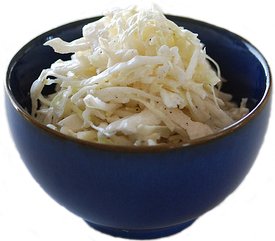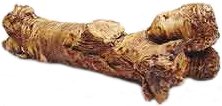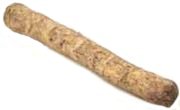

Horseradish

Armoracia. (Classical Greek name for horseradish.) Cruciferae. Three species of perennial herbs, to 2m. Roots branched, woody or fleshy. Leaves variable; basal leaves small or to 1m, simple or pinnatifid, toothed, petiole variable; flowering stem leaves short-petioled to subsessile, entire on upper part of stem. Inflorescence a raceme or panicle, greatly elongating in fruit; flowers small; sepals 4, oblong to ovate, spreading, glabrous; petals 4, white, oblanceolate to spathulate, short-clawed; stamens 6. Fruit a silicle, glabrous, oblong to obovate, subsessile, compound. SE Europe to Siberia. CultivationNative to temperate regions of Europe and Asia and naturalised in North America, the fleshy taproots of Armoracia rusticana regenerate so prolifically that in some areas it has become a pernicious weed. It has been widely cultivated as a medicinal and condiment herb since ancient times and because of its ancient history is now found growing naturally on streamsides, roadsides, railway embankments and waste ground at low altitudes throughout the temperate zones. The variegated form is sometimes grown as an ornamental. Horseradish can be grown either as a perennial or treated as an annual by replanting in a fresh site each year. Grow in a well-drained, friable soil richly supplied with well-rotted manure, and deeply cultivate during the winter. Where rotation is practised, follow a heavily manured crop, such as peas or beans. Prepare bundles of 15-20cm-long, pencil-thick roots (thongs) in winter, and store in sand, in cool conditions, but above freezing. When sprouts appear in early spring, plant firmly 5-7cm deep, at 45cm intervals in rows 60cm apart. Apply a topdressing of complete garden fertiliser and water thoroughly in dry weather. Harvest in autumn, by cutting down the foliage and lifting the roots (ensure that this is done thoroughly to avoid unwanted regeneration). Portions of root remaining in the soil following harvesting will ensure a continued supply of roots for harvesting in subsequent seasons. To maintain production of well-shaped taproots, production beds should be renewed approximately every three years, when care should be taken to eliminate all remaining portions of root to prevent the development of troublesome weeds. Store in cool, dark conditions, since the roots turn green on exposure to light. A better-quality crop can be produced by root stripping. When the top growth reaches 20-30cm in height, remove topsoil and rub off side shoots, leaving those at the lower end undisturbed. Repeat six weeks later. 
Excess nitrogen causes heavy top growth and forking of the roots. The so-called pale leaf spot of horseradish is caused by the fungus Ramularia armoraciae. The centres of the white, papery spots often fall out leaving ‘shot holes’. The quality of the roots is probably not affected, so no control measure are necessary. Horseradish is also susceptible to many of the diseases which affect brassicas including black rot (Xanthomonas campestris), clubroot (Plasmodioiphora brassicae), white blister (Albugo candida) and turnip mosaic virus, which produces large yellow blotches and necrotic ringspots on the leaves of this host. Armoracia rusticanaHORSERADISH; RED COLE. To 1m. Stock stout, roots fleshy. Basal leaves 30-50cm, ovate-oblong, serrate to crenate; petiole to 30cm. Flowering stem leaves sessile or subsessile. Flowers in a terminal panicle; petals 5-7mm. Fruit 4-6mm, globose or ovoid. Spring. SE Europe, naturalised throughout Europe and N America. Viable seed rarely sets in cultivation. Z5. ‘Bohemian’ or ‘Maliner Kren’ are all vigorous with bare white roots. ‘Big Top’ is a recent introduction with good disease resistance. ‘Hybrid’ and ‘Newcastle Ivory’ are other improved cultivars. ‘Variegata’: leaves splashed cream or white.
|
Home
Grow Nuts
Grow Herbs
Grow Fruit
Cyberian Index
If you like this website and want one of your own contact
Cyberian All information correct at
time of publication and open to updates as necessary. No part of this website,
or its vectors, may be produced in any shape or form, using any type or design
of medium, system, equipment or otherwise without the prior written consensual
notice of the Cyberian. Any breach of these requirements will result in the
appropriate action. If in doubt, e-mail contact is recommended.
Some components of this website were obtained as open-source software and are
used in the same non-profit manner on this website.